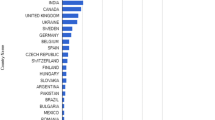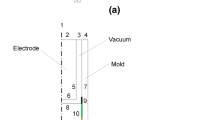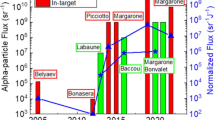Abstract
Tungsten (W) plays a crucial role in the lifetime of the plasma-facing components of DEMO. In order to avoid oxidation, W-based alloys have been studied as alternatives to W. In this work, the Monte Carlo SRIM-2013 simulation program was used to calculate the nuclear stopping power, electronic stopping power, amount of target vacancies, displacements, replacement collisions, and total target damage of W, W-Cr-Si, W-Cr-Ti, and W-Cr-Y by hydrogen and helium ion bombardment. It is found that W is resistant to vacancies, atomic displacement, and total damage compared to W-based alloys.






Similar content being viewed by others
References
Minucci S, Panella S, Ciattaglia S, Falvo MC, Lampasi A (2020) Electrical loads and power systems for the DEMO nuclear fusion project. Energies 13(9):2269
Federici G, Boccaccini L, Cismondi F, Gasparotto M, Poitevin Y, Ricapito I (2019) An overview of the EU breeding blanket design strategy as an integral part of the DEMO design effort. J Fus Eng Design 141:30–42
Day Chr, Butler B, Giegerich T, Lang PT, Lawless R, Meszaros B (2016) Consequences of the technology survey and gap analysis on the EU DEMO R&D programme in tritium, matter injection and vaccum. J Fus Eng Design 109:299–308
Pitts RA, Carpentier S, Escourbiac F, Hirai T et al (2011) Physics basis and design of the ITER plasma-facing components. J Nucl Mater 415(1):S957–S964
Troev T, Popov E, Staikov P, Nankov N, Yoshiie T (2009) Positron simulations of defects in tungsten containing hydrogen and helium. J Nucl Instrum Methods Phys B 267(3):535–541
Pospieszczyk A, Brezinsek S, Mertens Ph, Sergienko G (2002) The role of hydrogen atoms and molecules in the plasma boundary. Contrib Plasma Phys 42(6–7):663–667
Fu T, Cui K, Zhang Y, Wang J, Shen F, Yu L, Qie J, Zhang X (2021) Oxidation protection of tungsten alloys for nuclear fusion applications: A comprehensive review. J Alloys Compd 884:161057
Litnovsky A, Schmitz J, Klein F, Lannoye KD et al (2020) Smart tungsten-based alloys for a first wall of demo. J Fus Eng Design 159:111742
Bachurina D, Tan XY, Klein F, Suchkov A, Litnovsky A et al (2021) Self-passivating smart tungsten alloys for DEMO: a progress in joining and upscale for a first wall mockup. Tungsten 3(1):101–115
Litnovsky A, Klein F, Tan X, Ertmer J et al (2021) Advanced self-passivating alloys for an application under extreme conditions. Metals 11(8):1255
Yi G, Liu W, Ye C, Xue L, Yan Y (2021) A self-passivating W-Si-Y alloy: Microstructure and oxidation resistance behavior at high temperatures. Corros Sci 192:109820
Koch F, Bolt H (2007) Self passivating W-based alloys as plasma facing material for nuclear fusion. Physica Scripta 2007 (T128):100
Koch F, Kôppl S, Bolt H (2009) Self passivating W-based alloys as plasma facing material. J Nucl Mater 386:572–574
Liu DG, Zheng L, Luo LM, Zan X, Song JP, Xu Q, Zhu XY, Wu YC (2018) An overview of oxidation-resistant tungsten alloys for nuclear fusion. J Alloys Compd 765:299–312
Hou QQ, Huang K, Luo LM, Tan XY, Zan X, Xu Q, Zhu XY, W YC (2019) Microstructure and its high temperature oxidation behavior of W-Cr alloys prepared by spark plasma sintering. Materialia 6:100332
Zhao Z, Li Y, Zhang C, Pan G, Tang P, Zeng Z (2017) Effect of grain size on the behavior of hydrogen/helium retention in tungsten: a cluster dynamics modeling. J Nucl fus 57(8):086020
Brooks JN, Allain JP, Doerner RP, Hassanein A, Nygren R, Rognlien TD, Whyte DG (2009) Plasma-surface interaction issues of an all-metal ITER. J Nucl fus 49(3):035007
Correa AA (2018) Calculating electronic stopping power in materials from first principles. Comput Mater Sci 150:291–303
Andersen HH, Brunelle A, Della-Negra S, Depauw J, Jacquet D, Beyec YL, Chaumont J, Bernas H (1998) Giant metal sputtering yields induced by 20-5000 keV/atom gold clusters. Phys Rev lett 80(24):5433
Meluzova DS, Babenko PY, Shergin AP, Nordlund K, Zinoviev AN (2019) Reflection of hydrogen and deuterium atoms from the beryllium, carbon, tungsten surfaces. J Nucl Instrum Methods Phys B 460:4–9
Zinov’ev AN, Babenko PY (2020) Nuclear stopping power of hydrogen and helium isotopes in beryllium, carbon, and tungsten. Tech Phys Lett 46(9):909–912
Weber WJ, Zhang Y (2019) Predicting damage production in monoatomic and multi-elemental targets using stopping and range of ions in matter code: Challenges and recommendations. Curr Opin Solid State Mater Sci 23(4):100757
Paul H (2013) Nuclear stopping power and its impact on the determination of electronic stopping. Power-AIP Conference Proceedings 1525(1):309–313
DIB A, Ammi H, Msimanga M, Mammeri S, Pineda-Vargas CA (2019) Energy loss and stopping force of heavy ions Cu,Si, Al and F through thin Nickel (Ni) foil at low MeV energies. J Nucl Instrum Methods Phys B 450:43–46
Duan G, Xing T, Li Y (2012) Preferential sputtering of Ar ion processing SiO2 mirror. AOMATT, the 6th International Symposium on advanced Optical Manufacturing and Testing Technologies 8416:585–592
Anderson HH, Ziegler JF (1977) Helium stopping powers and ranges in all elements
Saha U, Devan K, Ganesan S (2018) A study to compute integrated dpa for neutron and ion irradiation environments using SRIM-2013. J Nucl Mater 503:30–41
Ahn HS, Kim TE, Cho E, Ji M, Lee CK, Han S, Cho Y, Kim C (2008) Molecular dynamics study on low-energy sputtering properties of MgO surfaces. J Appl Phys 103(7):073518
The stopping and range of Ions in Matter [online]. www.srim.org
Yalçin C(2015) Thickness measurement using alpha spectroscopy and SRIM. J Physics: Conference Series. IOP Publishing 590(1): 012050
Zhang Y, Lian J, Zhu Z, Bennett WD, Saraf LV, Rausch JL, Hendricks CA, Ewing RC, Weber WJ (2009) Response of strontium titanate to ion and electron irradiation. J Nucl Mater 389(2):303–310
Litnovsky A, Wegener T, Klein F, Linsmeier C et al (2017) Advanced smart tungsten alloys for a future fusion power plant. Plasma Phys Controlled Fusion 59(6):064003
Rautray TR, Narayanan R, Kim KH (2011) Ion implantation of titanium based biomaterials. Prog Mater Sci 56(8):1137–1177
Ali SH, Saeed SR (2014) Theoretical calculation of different ion surface interaction parameters of Si target. J zankoy sulaimani-Part (JZS-A) 16(1):1
Giri K, Kandel B (2020) Study of damage profiles and energy calculation of arsenic ions during ion implantation on germanium. BIBECHANA 17:96–103
Mahady K, Tan S, Greenzweig Y, Livengood R, Raveh A, Rack P (2016) Monte Carlo simulations of nanoscale Ne+ ion beam sputtering: investigating the influence of surface effects, interstitial formation, and the nanostructural evolution. Nanotechnology 28(4):045305
Acknowledgements
The authors declare that they have no known competing financial interests or personal relationships that could have appear to influence the work reported in this paper.
Author information
Authors and Affiliations
Corresponding author
Additional information
Publisher’s Note
Springer Nature remains neutral with regard to jurisdictional claims in published maps and institutional affiliations.
Rights and permissions
About this article
Cite this article
El Marsi, M., Elmaddahi, Z., Fechtal, I. et al. Simulation study of stopping power and damage profiles of H/He plasma irradiation in tungsten and its alloys for fusion power plant. J Radioanal Nucl Chem 331, 3795–3806 (2022). https://doi.org/10.1007/s10967-022-08415-w
Received:
Accepted:
Published:
Issue Date:
DOI: https://doi.org/10.1007/s10967-022-08415-w




